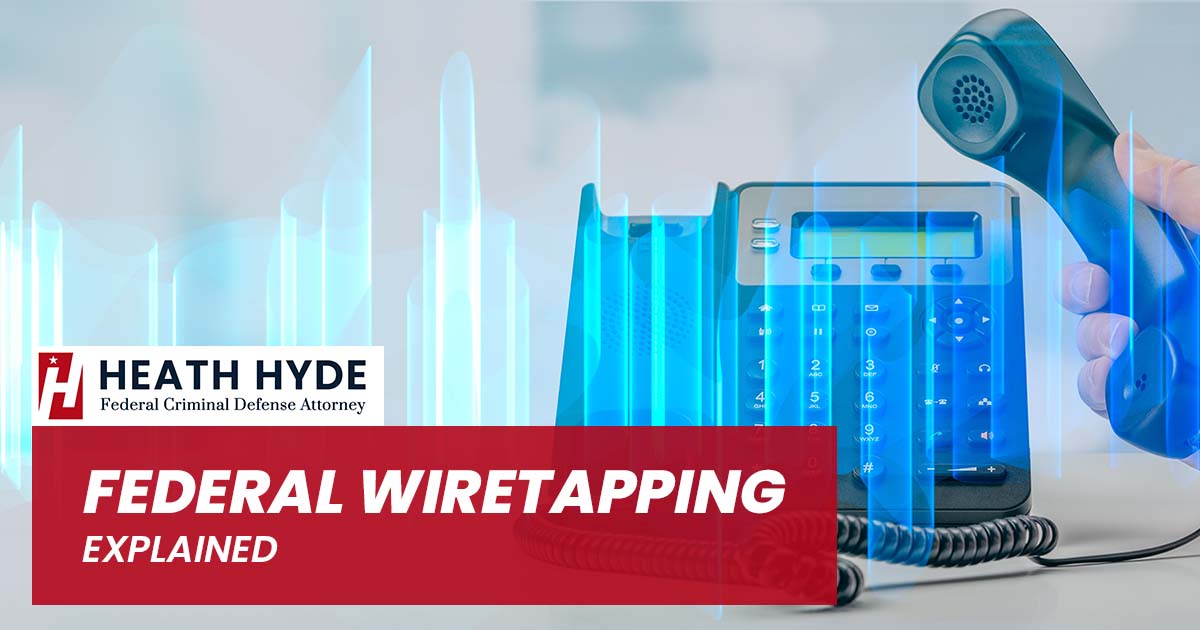Prosecutors utilize wiretapping to acquire evidence for use in court in this age of heightened surveillance and technology.
Wiretaps are frequently employed in the investigation of white-collar crimes, homicide, and kidnapping. The most typical application of a title 3 wiretap, however, is in the investigation and prosecution of illegal drug trafficking. Wiretapping rules, on the other hand, compel investigators to jump through a series of procedural hoops, and failure to comply with the severe wiretap warrant requirements may result in the case being dismissed.
You have choices if you fear that you are being wiretapped or if a case has been filed against you based on evidence gained through eavesdropping. State and federal rules exist to regulate how police and prosecutors obtain evidence through surveillance in the interest of preserving privacy.
Wiretapping Regulations
When a third party secretly observes conversations in order to investigate an interested party, this is known as wiretapping. Intercepted phone calls or recorded in-person chats are the most common images that come to mind. In actuality, wiretapping regulations apply to any intercepted wire, oral, or electronic communication.
Wiretappings can be used to investigate murder, kidnapping, drug trafficking, and any other crime that is “dangerous to life, limb, or property” and is punishable by more than a year in jail. Wiretapping or oral intercepts, on the other hand, are restricted to the investigation of a vast and diverse list of specific offenses. 2516 of the United States Code
State of One-Party Consent
The regulations governing the recording of another person without their agreement vary by state. Some states, known as two-party consent states, require that both the recording party and the party being recorded be aware that their communication is being recorded. In contrast, Arizona is a one-party consent state, which means you don’t need to get someone’s permission before recording them.
When a party secretly records another party in a state of undress or in a setting where one would expect to undress, it is an exception to the one-party consent state rule (bathroom, locker room for example). The government (police) attempting to listen in on and record your discussions is the other exception to this rule. A warrant and an order from a court are required for a title 3 wiretap in these circumstances
Requirements for Wiretapping Warrants
Police must follow very tight protocols both before and after acquiring a wiretap. The authorities must first get a particular sort of wiretap warrant in order to intercept a person’s phone calls, text messages, or emails. The following are the requirements for a wiretap warrant:
The 7 Steps to a Wiretapping Order and Application
- Eligible Applicants. The Attorney General, Assistant Attorney General, or the State’s principal prosecuting attorney must first approve the application for a State wiretapping. 18 U.S.C. § 2516(1)-(2). The usage of an Assistant District Attorney or Deputy County Attorney, as used in Texas, is not included in the federal statute. Suppression can occur if the proper clearances are not obtained.
- Application Specificity. Each application must include a specified statutory statement of information that includes, in particular, the following information:
- The agency and agent who are requesting the wiretap;
- A factual assertion;
- Other methods of investigation that have been tried and failed;
- The duration of the interception (no more than 30 days – extensions may be granted if reapplied for);
- a disclosure of the facts relating to all previously approved applications; and
- A statement of the results to date if the application is for an extension to a previous application.
- Necessity or Exhaustion. Wiretaps, unlike other investigations, have an added layer of protection and require a specialized warrant.
The agency must persuade the court that phone call interceptions are necessary since all other methods of data collection have failed to provide law enforcement with the information they require.
The procedure that law enforcement must demonstrate to the court is known as “exhaustion.” The following are some of the techniques that law enforcement must “exhaust” before getting a wiretap:- Trash ripping (searching the garbage of a suspect);
- Surveillance through physical means
- Surveillance of cell phones (pen registration and trap and track);
- confidential sources; confidential sources; confidential sources; confidential sources; confidential sources; confidential sources; confidential sources;
- The use of tracking devices;
- Mail interception;
- Taking pictures of suspects;
- Photographing automobiles and matching them to their registration numbers;
- Cars that have recently crossed the border with cars at a certain target point are being tracked.
- Minimization Requirements.There are times when law enforcement must stop listening to phone calls after they have started listening. The following are some examples of intercepted communication that law enforcement cannot listen to:
- Telephone conversations between husband and wife; or
- Discussions with health-care providers and insurance companies; or
- Calls to lawyers; or
- Conversations with a pastor or other members of the clergy; or
- Conversations that have nothing to do with the investigation (spot-monitoring may occur).
NOTE: If privileged calls are necessary for the inquiry, they can be listened to. If an attorney is helping in illegal activities rather than providing legal advice, for example. It’s also worth noting that courts tend to allow law enforcement more discretion on minimization early in an investigation, but will likely require more stringent adherence to minimization rules later on.
- Interim reporting. While calls are being intercepted as part of a wiretap, police enforcement is frequently compelled to give ongoing reports to the court regarding the approved purpose and the need for further surveillance. The court determines the frequency of these reports, but they are typically due 10 to 15 days following each application and order. A.R.S § 13-3010(K); 18 U.S. Code § 2518(6)
- Termination. A wiretap can only be used for 30 days to intercept calls. Furthermore, the wire must be cut once the investigating authority has collected the information sought in the application. Instead, if evidence is obtained during the interception period that leads to further inquiry, law enforcement might request an extension. Police can request an unlimited number of extensions as long as fresh evidence is presented.
- Sealing. The recordings must be made accessible to the judge who issued the order within ten days of the end of the authorized interception and sealed according to the judge’s instructions. If evidence is not sealed, it must be accompanied by a “satisfactory explanation” before it can be utilized. While extensions may be granted, the evidence in each order should be sealed in accordance with state and federal laws. A.R.S § 13-3010(H).
Wiretap Evidence vs. Cell Phone Surveillance
In contrast to a wiretap or wiretapping, mobile phone surveillance involves the collection of cell detail records. Both require probable cause and a warrant, but cell phone surveillance can also offer evidence of your geographical location on a certain date and time by preserving your call and text history.
A title 3 wiretap, on the other hand, is used to intercept and record actual live phone calls, messages, or emails.
Cellular Tower Information
In the course of a criminal investigation, police enforcement frequently obtains warrants for a specific phone number from a cell phone service provider in order to track down a suspect’s whereabouts and call and text history.
The position of a person is determined by examining the data sent and received by your mobile phone from the cell phone tower that services the area in which the phone is located on a given date and time.
After a crime has been committed, this information is usually received. At a murder scene, for example, police may have a suspect and seek a warrant in order to place the suspect’s phone near the crime scene.
After a crime has been committed, police can also get orders to know the location of all phones near a specific cell tower. Police can acquire a warrant to describe all phones that were near a given cell tower on a specific date and time to construct a suspect list using this dragnet strategy.
Police can also get a live glimpse of a phone number’s call and text history, as well as application details, while an investigation is ongoing (social media use). This information, also known as a pen registry or a trap and trace, allows investigators to monitor a specific phone and view the call and text history in real time. Prior to securing an official wiretap, this material is frequently used for probable cause.
The date, time, and position of the device, as well as the phone numbers communicating with one another, will be included in the cell detail information acquired from cell phone providers, but not the substance of a conversation or text message. Police must get a wiretap in order to intercept a specific communication or call.
Data Collected from a Physical Phone
An examination of a physical cell phone can also be used to obtain cell phone surveillance. During questioning or after an arrest, cops will frequently ask if you consent to a phone search. If you don’t have a password for your phone, authorities may open it and go through your data, including your location, calls, and text messages.
If your phone uses fingerprint or facial recognition to unlock it, officers may hold the phone up to your face or place your finger on the screen to unlock it. Because you have no right to privacy when it comes to your fingerprints or facial identity, this technique is usually determined to be constitutional.
If you have a numeric password, you have the right under the fifth amendment to refuse to speak and provide the police with your password.
If you refuse to allow authorities to search your phone, they may acquire a warrant and extract data from your phone using software. Celibrite program is the most widely utilized software.
The data on your phone can be extracted using this program by forensic professionals. The following is a list of data that can be extracted with the Cecibrite software:
- Phone calls (just numbers);
- (numbers and content of text messages);
- Information about the location;
- Images with GPS coordinates;
- Information from social media (including messaging).
Defenses in Wiretap Cases
Wiretap cases, like any other criminal case, have typical defenses that a skilled wiretap lawyer should use. Among the most prevalent defenses are:
Investigation and evidence that isn’t trustworthy.
This entails questioning the police investigation’s competence and the validity of the evidence utilized against you. Your lawyer will advise you on whether you should employ an independent defense expert to assess and combat the prosecution’s evidence.
Identity Mistake.
Mistaken identification can manifest itself in a variety of ways. If, on the other hand, the prosecution labels you as the defendant based on eyewitness identification, you should consider challenging the eyewitness’ testimony. Eyewitness testimony has been proven to be one of the least trustworthy forms of evidence. Other times, a suggestive photo lineup may be used to identify you, resulting in concerns with misidentification.
The mere fact of being present.
You should raise a mere presence defense if you were just there when a criminal was committed, even if you were aware that a crime was being committed. You did not have any criminal intent and did not participate in the act if you were simply present at the crime site.
Alibi.
When you have evidence that you were somewhere else at the time of the crime, you might use an alibi defense.
However, in addition to the defenses mentioned above, wiretap cases can be attacked in various ways. Because wiretapping cases necessitate rigorous adherence to wiretap warrant requirements, even the tiniest error by law enforcement might imperil the entire wiretap. The following are some examples of wiretap defenses:
Wiretap Applications that are difficult to use.
Applications that are unconstitutionally broad or have a lack of specificity may be challenged. Successful challenges to the wiretap application’s rigorous statutory compliance or constitutional violations may result in the case being dismissed.
Exhausting Requirements are being tackled.
If it is determined that law enforcement did not explore all other channels of investigation before filing a wiretap application, the entire wire might be declared invalid. The recorded evidence acquired will be suppressed if the wiretapping application is invalid.
Minimization Obligations are being re-examined.
Certain calls must be cut off or minimized by law enforcement. If the evidence against a person was obtained as a result of a call that should have been avoided, the evidence can be suppressed and used against them.
Examining the Legal Obligations of Judicial Sealing The wiretap statute stipulates that any evidence gathered must be sealed at the end of the order’s duration. Evidence sealing prevents law enforcement from tampering with evidence that has already been gathered. Failure to have the recordings sealed in a timely way (10 days) can result in the recordings being suppressed and the case being dismissed.
Co-conspirator Statements Face Challenges These are special hearings that take place prior to a jury trial and are known as James hearings because they are based on a Supreme Court case called U.S. v James. If the defense is successful in proving that the statements were not made in furtherance of the crime, the number of recorded statements that can be used against a client is limited.
If the government illegally violated your privacy in order to collect evidence and build a case against you, that evidence shouldn’t be used to determine your fate or the fate of a loved one. Contact us today for a free & confidential consultation. Call 903.439.0000






